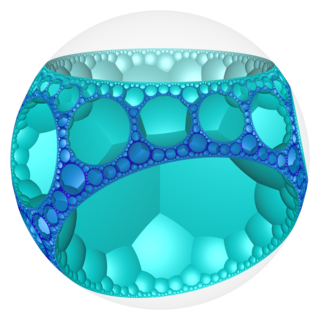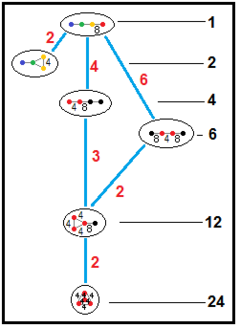In the geometry of hyperbolic 3-space, the heptagonal tiling honeycomb or 7,3,3 honeycomb a regular space-filling tessellation (or honeycomb). Each infinite cell consists of a heptagonal tiling whose vertices lie on a 2-hypercycle, each of which has a limiting circle on the ideal sphere.
Geometry
The Schläfli symbol of the heptagonal tiling honeycomb is {7,3,3}, with three heptagonal tilings meeting at each edge. The vertex figure of this honeycomb is a tetrahedron, {3,3}.
Related polytopes and honeycombs
It is a part of a series of regular polytopes and honeycombs with {p,3,3} Schläfli symbol, and tetrahedral vertex figures:
| {p,3,3} honeycombs
|
| Space
|
S3
|
H3
|
| Form
|
Finite
|
Paracompact
|
Noncompact
|
| Name
|
{3,3,3}
|
{4,3,3}
|
{5,3,3}
|
{6,3,3}
|
{7,3,3}
|
{8,3,3}
|
... {∞,3,3}
|
| Image
|

|

|

|

|

|

|

|
Coxeter diagrams

|
1
|
      
|
      
|
      
|
      
|
      
|
      
|
      
|
| 4
|
|
      
|
|
      
|
|
      
|
      
|
| 6
|
|
      
|
|
      
|
|
      
|
      
|
| 12
|
|
    
|
|
    
|
|
     
|
     
|
| 24
|
|
  
|
|
  
|
|

|

|
Cells
{p,3}
    
|

{3,3}
    
|

{4,3}
    
    
  
|

{5,3}
    
|

{6,3}
    
    
  
|

{7,3}
    
|

{8,3}
    
    
   
|

{∞,3}
    
    
   
|
It is a part of a series of regular honeycombs, {7,3,p}.
| {7,3,3}
|
{7,3,4}
|
{7,3,5}
|
{7,3,6}
|
{7,3,7}
|
{7,3,8}
|
...{7,3,∞}
|

|

|

|

|

|

|

|
It is a part of a series of regular honeycombs, with {7,p,3}.
Octagonal tiling honeycomb
| Octagonal tiling honeycomb
|
| Type |
Regular honeycomb
|
| Schläfli symbol |
{8,3,3}
t{8,4,3}
2t{4,8,4}
t{4[3,3]}
|
| Coxeter diagram |
      
      
      
    
     (all 4s) (all 4s)
|
| Cells |
{8,3} 
|
| Faces |
Octagon {8}
|
| Vertex figure |
tetrahedron {3,3}
|
| Dual |
{3,3,8}
|
| Coxeter group |
[8,3,3]
|
| Properties |
Regular
|
In the geometry of hyperbolic 3-space, the octagonal tiling honeycomb or 8,3,3 honeycomb a regular space-filling tessellation (or honeycomb). Each infinite cell consists of an octagonal tiling whose vertices lie on a 2-hypercycle, each of which has a limiting circle on the ideal sphere.
The Schläfli symbol of the octagonal tiling honeycomb is {8,3,3}, with three octagonal tilings meeting at each edge. The vertex figure of this honeycomb is an tetrahedron, {3,3}.
Apeirogonal tiling honeycomb
| Apeirogonal tiling honeycomb
|
| Type |
Regular honeycomb
|
| Schläfli symbol |
{∞,3,3}
t{∞,3,3}
2t{∞,∞,∞}
t{∞[3,3]}
|
| Coxeter diagram |
      
      
      
     
     (all ∞) (all ∞)
|
| Cells |
{∞,3} 
|
| Faces |
Apeirogon {∞}
|
| Vertex figure |
tetrahedron {3,3}
|
| Dual |
{3,3,∞}
|
| Coxeter group |
[∞,3,3]
|
| Properties |
Regular
|
In the geometry of hyperbolic 3-space, the apeirogonal tiling honeycomb or ∞,3,3 honeycomb a regular space-filling tessellation (or honeycomb). Each infinite cell consists of an apeirogonal tiling whose vertices lie on a 2-hypercycle, each of which has a limiting circle on the ideal sphere.
The Schläfli symbol of the apeirogonal tiling honeycomb is {∞,3,3}, with three apeirogonal tilings meeting at each edge. The vertex figure of this honeycomb is an tetrahedron, {3,3}.
The "ideal surface" projection below is a plane-at-infinity, in the Poincare half-space model of H3. It shows an Apollonian gasket pattern of circles inside a largest circle.

































